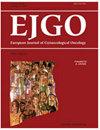卵巢癌患者在二线治疗环境中的BRCA筛查、治疗模式和反应:来自真实世界调查的结果
IF 0.5
4区 医学
Q4 OBSTETRICS & GYNECOLOGY
引用次数: 1
摘要
目的:尽管现在建议对诊断为癌症(OC)的患者进行BRCA基因检测,但各国的检测水平在很大程度上是未知的。本研究描述了BRCA突变筛查模式和结果、人口统计学、临床特征以及在二线(2L)治疗环境中晚期OC患者的真实样本中使用聚ADP核糖聚合酶抑制剂(PARPi)作为维持治疗。方法:使用Adelphi真实世界OC疾病特异性计划(DSP)收集数据™, 2017年12月至2018年3月,在欧洲(欧盟5国:法国、德国、意大利、西班牙和英国)和美国(美国)对医生及其临床实践中OC咨询患者进行的时间点调查。医生为接下来的八名连续咨询患者填写了一份详细的患者记录表,记录了他们的临床病史和治疗数据。所有分析均为描述性分析。结果:在确定的1315名患者中,1096名(83%)正在接受2L治疗,219名(17%)正在接受3L维持治疗;PARPi(奥拉帕尼、鲁卡帕利或尼拉帕利,n=103)或非PARPi患者(n=116)。BRCA筛查率因国家而异,随着每种治疗方法的增加而增加,欧盟5国(55%)高于美国(44%)。接受2L治疗的患者中有28%的BRCA1/2突变。接受PARPi维持治疗的患者比接受2L治疗或非PARPi治疗的患者具有更好的东部肿瘤协作组(ECOG)表现状态、更高的BRCA筛查率和更高的浆液性上皮OC比例。选择2L治疗的常见原因是无进展/总体生存益处和生活质量的改善。结论:尽管指南建议对OC患者进行BRCA检测,但许多接受2L治疗的OC患者没有进行BRCA突变筛查。与PARPi在2L维持中的使用相关的决定似乎是由BRCA状态、组织学和对一线治疗的反应驱动的。本文章由计算机程序翻译,如有差异,请以英文原文为准。
BRCA screening, treatment patterns and response among patients with ovarian cancer in the second line treatment setting: results from a real world survey
Objective : Although BRCA gene testing of patients diagnosed with ovarian cancer (OC) is now recommended, the level of testing undertaken in various countries is largely unknown. This study describes BRCA mutation screening patterns and results, demographics, clinical characteristics and the use of poly (ADP-ribose) polymerase inhibitors (PARPi) as maintenance treatment within a real-world sample of patients with advanced OC in the second-line (2L) treatment setting. Methods : Data were collected using the Adelphi Real World OC Disease Specific Programme (DSP)™, a point-in-time survey of physicians and their consulting patients with OC in clinical practice, undertaken across Europe (EU5: France, Germany, Italy, Spain and United Kingdom) and the United States (US) between December 2017–March 2018. Physicians completed a detailed patient record form for their next eight consecutively consulting patients, capturing data on their clinical history and treatment. All analysis was descriptive. Results : Of 1315 patients identified, 1096 (83%) were receiving 2L treatment and 219 (17%) were receiving 2L maintenance treatment; either PARPi (olaparib, rucaparib or niraparib, n = 103) or a non-PARPi (n = 116). BRCA screening rates varied between countries, increased with each line of therapy and were higher in the EU5 (55%) than the US (44%). 28% of patients receiving 2L treatment had a BRCA1/2 mutation. Patients receiving PARPi maintenance treatment had better Eastern Cooperative Oncology Group (ECOG) performance status, higher BRCA screening rates and higher proportions of serous epithelial OC than those receiving 2L treatment or non-PARPi maintenance. Common reasons for choosing 2L treatments were progression-free/overall survival benefit and improvement of quality of life. Conclusions : Despite guidelines recommending BRCA testing in patients with OC, many OC patients undergoing 2L treatment were not screened for BRCA mutations. Decisions related to PARPi use in 2L maintenance appeared to be driven by BRCA status, histology and response to first-line treatment.
求助全文
通过发布文献求助,成功后即可免费获取论文全文。
去求助
来源期刊
自引率
25.00%
发文量
58
审稿时长
1 months
期刊介绍:
EJGO is dedicated to publishing editorial articles in the Distinguished Expert Series and original research papers, case reports, letters to the Editor, book reviews, and newsletters. The Journal was founded in 1980 the second gynaecologic oncology hyperspecialization Journal in the world. Its aim is the diffusion of scientific, clinical and practical progress, and knowledge in female neoplastic diseases in an interdisciplinary approach among gynaecologists, oncologists, radiotherapists, surgeons, chemotherapists, pathologists, epidemiologists, and so on.

 求助内容:
求助内容: 应助结果提醒方式:
应助结果提醒方式:


